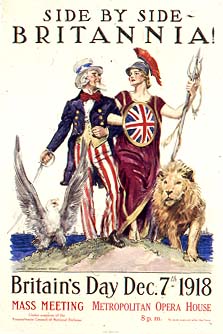Personificazione nazionale

La personificazione nazionale è un'antropomorfizzazione di una nazione, usata solitamente per scopi illustrativi o propagandistici.
Storia
[modifica | modifica wikitesto]
Nelle prime personificazioni nel mondo occidentale si impiegavano divinità guerriere o figure simbolo di saggezza (ad esempio la dea Atena in Grecia), a indicare la forza e il potere della nazione. Spesso i nomi derivano da quelli latini delle province romane: casi tipici sono Britannia, Germania e Helvetia.
Esempi di personificazione della Dea della Libertà includono Marianne, la Statua della Libertà e molti esempi di moneta degli Stati Uniti; esempi di rappresentazioni di ogni uomo o del cittadino, piuttosto che della nazione stessa, sono Deutscher Michel e John Bull[1].
Elenco per nazione
[modifica | modifica wikitesto]Note
[modifica | modifica wikitesto]- ^ Eric Hobsbawm, Mass-Producing Traditions: Europe, 1870-1914, in Eric Hobsbawm e Terence Ranger (a cura di), The Invention of Tradition, Cambridge, 1983, pp. 263-307.
- ^ J. B. Minahan, p. 303, 2009.
- ^ J. B. Minahan, p. 216, 2009.
- ^ (EN) Nancy Hanway, Embodying Argentina: Body, Space and Nation in 19th Century Narrative, McFarland, 2003, p. 147, ISBN 978-0-7864-8245-0.
- ^ J. B. Minahan, p. 309, 2009.
- ^ J. B. Minahan, p. 314, 2009.
- ^ J. B. Minahan, p. 317, 2009.
- ^ J. B. Minahan, p. 228, 2009.
- ^ J. B. Minahan, p. 681, 2009.
- ^ J. B. Minahan, pp. 231-232, 2009.
- ^ J. B. Minahan, p. 377, 2009.
- ^ a b K. Kriz et al., p. 85, 2012.
- ^ J. B. Minahan, p. 153, 2009.
- ^ J. B. Minahan, p. 390, 2009.
- ^ K. Kriz et al., p. 87, 2012.
- ^ J. B. Minahan, p. 398, 2009.
- ^ J. B. Minahan, p. 408, 2009.
- ^ J. B. Minahan, p. 416, 2009.
- ^ Verena Widorn, When Countries Become Gods: The Geospatial Aspect of Deities in India, K. Kriz et al. (a cura di), pp. 84-87, 2012.
- ^ J. B. Minahan, p. 67, 2009.
- ^ J. B. Minahan, p. 431, 2009.
- ^ (EN) Daisy L. Neijmann (a cura di), A History of Icelandic Literature, vol. 5, U of Nebraska Press, 2006, p. 518, ISBN 978-0-8032-3346-1.
- ^ J. B. Minahan, p. 597, 2009.
- ^ J. B. Minahan, p. 438, 2009.
- ^ J. B. Minahan, p. 101, 2009.
- ^ (EN) The Maltese Identity. Allegoric Representation of Malta (PDF), su centralbankmalta.org, Central Bank of Malta. URL consultato il 12 ottobre 2015.
- ^ a b J. B. Minahan, p. 491, 2009.
- ^ a b J. B. Minahan, p. 482, 2009.
- ^ J. B. Minahan, p. 276, 2009.
- ^ J. B. Minahan, p. 495, 2009.
- ^
«Zé Povinho is a peronofication of the Portuguese working class; Eu Nacional, the national self, is a personification of the Portugal to come; Lusitania, from the Roman name for the region, is a personification of Portugal; and Répubblica, an effeùigy of the republic, is a national personification symbolizing the republic.»
- ^ J. B. Minahan, p. 565, 2009.
- ^ J. B. Minahan, p. 503, 2009.
- ^ (EN) Eyal Lewin, National Resilience During War: Refining the Decision-making Model, Lexington Books, 2012, p. 246, ISBN 978-0-7391-7458-6.
- ^ (EN) Jane Elizabeth Cody, Birthing Eternity: A Different Perspective on the Four Horsemen of Revelation, WestBow Press, 2013, pp. 185-486, ISBN 978-1-4497-8335-8.
- ^ J. B. Minahan, p. 539, 2009.
- ^ (EN) Origins. The Female Form as Allegory, su xroads.virginia.edu, America Studies at the University of Virginia. URL consultato il 4 ottobre 2015 (archiviato dall'url originale il 23 ottobre 2019).
- ^ (EN) Symbols. Lady Liberty's Male Relations, su xroads.virginia.edu, America Studies at the University of Virginia. URL consultato il 4 ottobre 2015 (archiviato dall'url originale il 23 ottobre 2019).
- ^ Per Columbia e Libertà si consulti anche: Amalia Avramidou, Denise Demetriou (a cura di), Approaching the Ancient Artifact: Representation, Narrative, and Function, Walter de Gruyter GmbH & Co KG, 2014, pp. 469-470, ISBN 978-3-11-030873-0.
- ^ J. B. Minahan, p. 543, 2009.
(EN) George Walton Scott, The Swedes: a jigsaw puzzle, Sidgwick & Jackson, 1967. - ^ J. B. Minahan, p. 547, 2009.
- ^ (EN) Timothy D. Hoare, Thailand: A Global Studies Handbook, ABC-CLIO, 2004, p. 115, ISBN 978-1-85109-685-5.
- ^ (EN) David Streckfuss, Truth on Trial in Thailand: Defamation, Treason, and Lèse-Majesté, Routledge, 2010, p. 271, ISBN 978-1-136-94202-0.
- ^ (EN) Elisabeth J. Friedman, Unfinished Transitions: Women and the Gendered Development of Democracy in Venezuela, 1936-1996, Penn State Press, 2010, p. 64, ISBN 978-0-271-04259-6.«Juan Bimba is a cartoon character who symbolizes "Mr. Ordinary Citizen, who in Venezuela is an illiterate peon" (Ferguson 1939, 65). While AD often used him in early campaigns to represent the average citizen whom it was going to empower, Juan Bimba ramanis today in Venezuelan political cartoons a caricature of the most victimized citizens - whose oppressors now include the political parties.»
Bibliografia
[modifica | modifica wikitesto]- (EN) James B. Minahan, The Complete Guide to National Symbols and Emblems, ABC-CLIO, 2009, ISBN 978-0-313-34497-8.
- (EN) Karel Kriz, William Cartwright, Michaela Kinberger (a cura di), Understanding Different Geographies, Springer Science & Business Media, 2012, ISBN 978-3-642-29769-4.
- (EN) Stefan Berger, Linas Eriksonas, Andrew Mycock (a cura di), Narrating The Nation: Representations in History, Media and the Arts, Berghahn Books, 2013, ISBN 978-0-85745-412-6.
Voci correlate
[modifica | modifica wikitesto]Altri progetti
[modifica | modifica wikitesto]Wikimedia Commons contiene immagini o altri file su personificazione nazionale